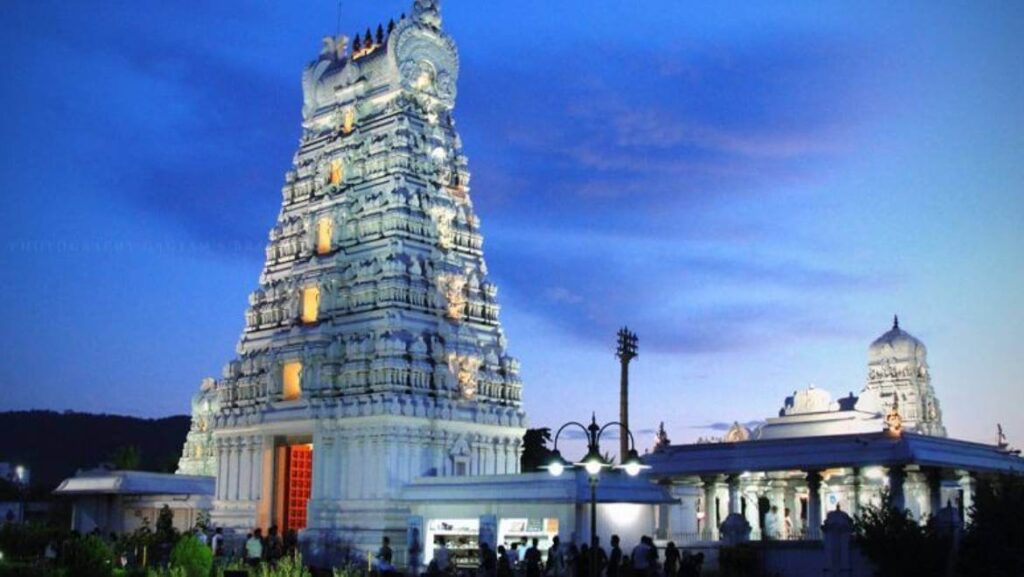The Amarnath Cave stands as one of Hinduism’s most revered pilgrimage destinations, drawing hundreds of thousands of devotees annually to witness a divine natural phenomenon deep within the Kashmir Himalayas. This sacred cave, located at an altitude of 3,888 meters (12,756 feet) in the Anantnag district of Jammu and Kashmir, houses a naturally formed ice lingam that devotees believe represents Lord Shiva himself. The pilgrimage to this holy shrine, known as the Amarnath Yatra, represents not merely a physical journey but a profound spiritual odyssey that tests faith, endurance, and devotion while offering glimpses of the divine in one of nature’s most spectacular settings.
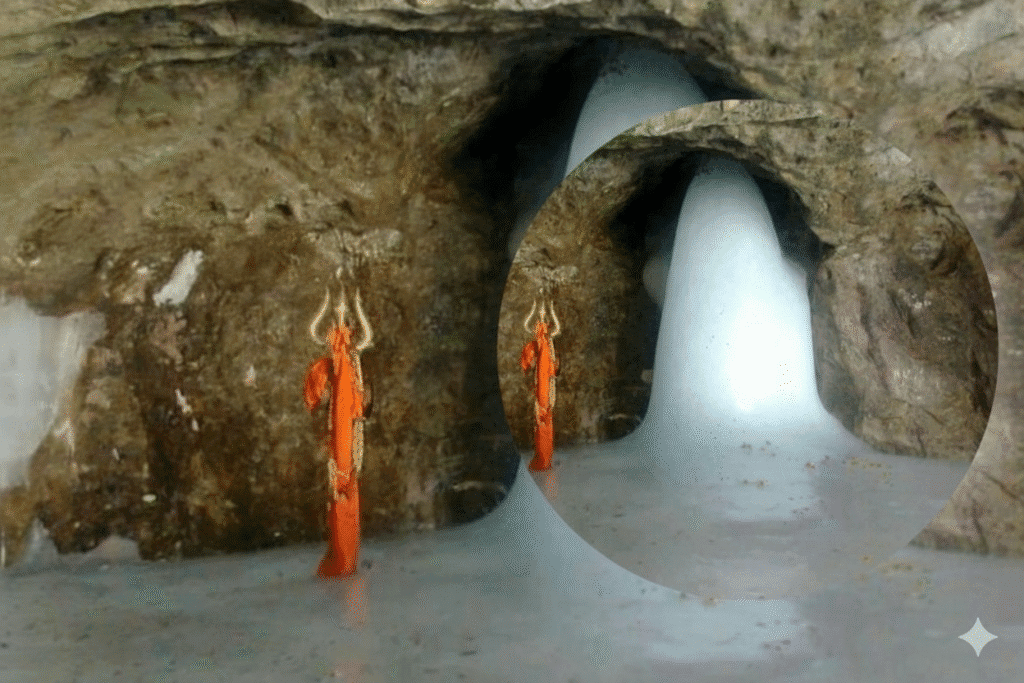
The natural ice Shiva Lingam inside Amarnath Cave, a revered Hindu pilgrimage site
The Sacred Ice Lingam: Nature’s Divine Creation
The Miraculous Formation
At the heart of the Amarnath Cave lies its most extraordinary feature—the Swayambhu (self-formed) ice lingam that forms naturally through a remarkable geological process. The lingam is created when water droplets from the cave’s limestone and gypsum roof freeze as they fall to the floor, gradually building upward to form a solid, dome-shaped ice stalagmite that can reach heights of up to five feet. This natural phenomenon occurs due to the unique combination of the cave’s altitude, temperature conditions, and the presence of multiple glaciers in the Lidder Valley that create hidden water pathways feeding into the cave.
The ice formation is accompanied by two smaller stalagmites that devotees believe represent Goddess Parvati and Lord Ganesha, creating a complete divine family within the sacred chamber. What makes this formation truly mystical is its cyclical nature—the lingam waxes and wanes with the phases of the moon, reaching its maximum size during the full moon of the Hindu month of Shravan (July-August) and diminishing during new moon periods.
Scientific Understanding and Environmental Concerns
Modern scientific analysis reveals that the lingam’s formation depends on complex environmental factors including temperature fluctuations, water flow patterns, and atmospheric conditions. However, climate change has begun to significantly impact this natural wonder. Recent studies indicate that the ice lingam now melts much faster than in previous decades, often disappearing by mid-July when it previously lasted through August. In 2025, over 250,000 pilgrims visited the cave, but 95% witnessed no ice lingam as it had melted over 50% before the yatra even began.
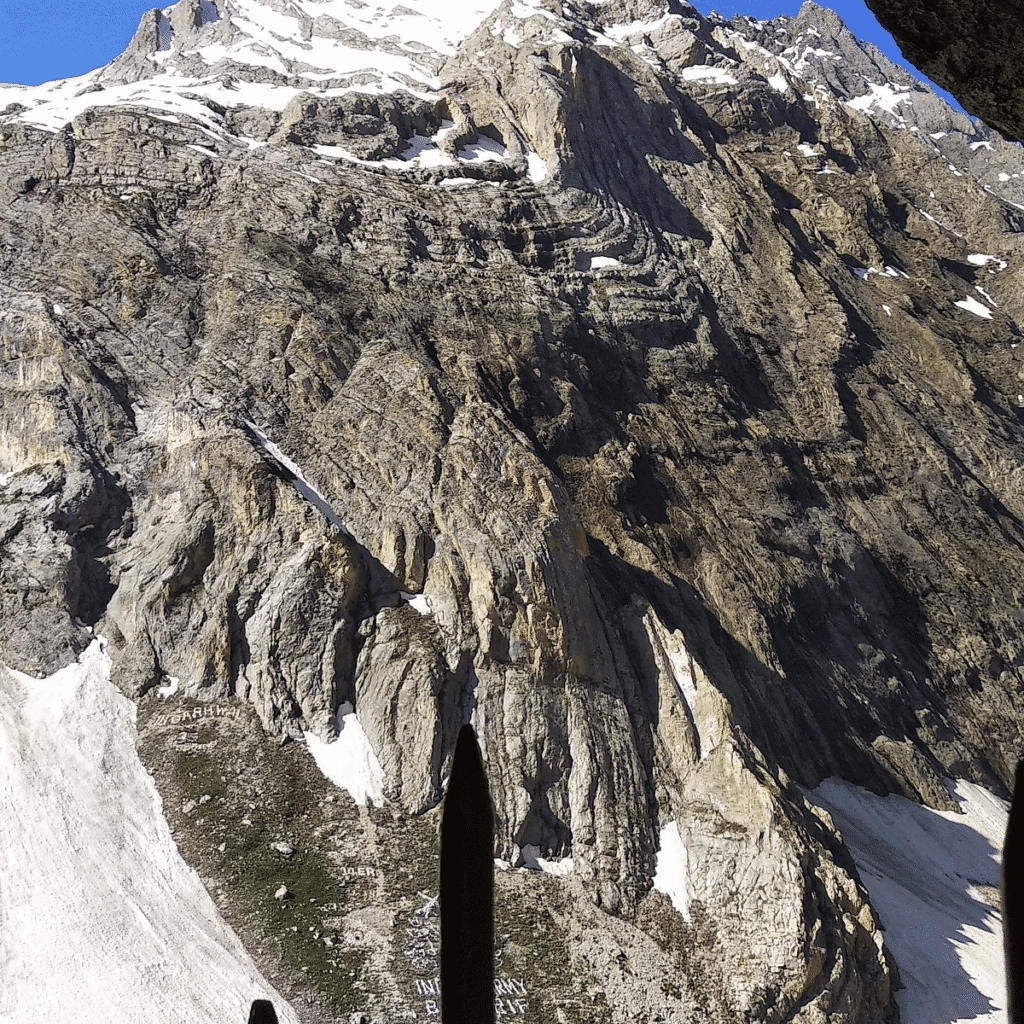
The rocky mountainous terrain and cave entrance in the Himalayas, representing the Amarnath Cave area
Mythological Significance and Ancient Legends
The Amar Katha: Tale of Immortality
The cave’s spiritual significance is deeply rooted in Hindu mythology, particularly the legend of Amar Katha (the story of immortality). According to ancient texts including the Amarnath Mahatmya and references in the Rajatarangini, Goddess Parvati questioned Lord Shiva about his immortality while she remained bound to the cycle of death and rebirth. To reveal this cosmic secret, Shiva chose the secluded Amarnath Cave as the perfect location where no living being could overhear the sacred discourse.
The journey to the cave itself became symbolic of renunciation and spiritual purification. As Shiva traveled to Amarnath, he systematically abandoned his worldly attachments: Nandi the bull at Pahalgam, the moon from his matted locks at Chandanwari, his snakes at Sheshnag Lake, Lord Ganesha at Mahagunas Mountain, and the five elements at Panchtarni. This progressive abandonment represents the spiritual seeker’s journey toward ultimate truth through detachment from material bonds.
The Immortal Doves
One of the most enchanting aspects of the Amarnath legend involves a pair of mating doves that inadvertently overheard Shiva’s discourse on immortality. According to tradition, these doves became immortal and continue to inhabit the cave. Pilgrims who spot these doves during their visit consider it an exceptionally auspicious blessing, adding another layer of mystique to the pilgrimage experience.
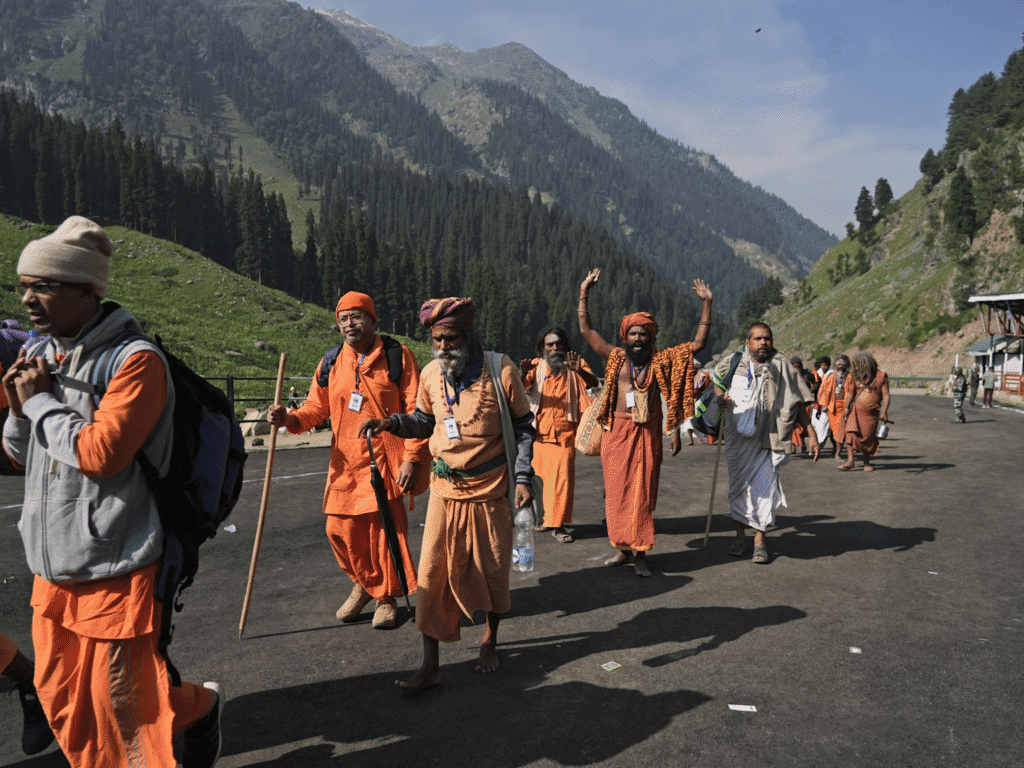
Pilgrims trekking during the Amarnath Yatra pilgrimage through the mountainous terrain of Kashmir
Historical Discovery and Rediscovery
Ancient Origins
Historical evidence suggests that the Amarnath Cave has been known since ancient times. The 12th-century chronicle Rajatarangini by historian Kalhana records that King Sandimati (34-17 BCE) visited the ice lingam, indicating that the shrine was already established over 2,000 years ago. Ancient texts including the Nilamata Purana, Bhrigu Samhita, and specific references in the Amarnath Mahatmya provide detailed accounts of the cave’s religious significance.
According to one legend, Sage Bhrigu was the first to discover the cave after the Kashmir Valley was drained of its ancient waters by Sage Kashyapa. This discovery marked the beginning of the cave’s recognition as a sacred pilgrimage site, though regular pilgrimages may have been interrupted during various historical periods.
Modern Rediscovery
The most popular narrative of the cave’s “rediscovery” involves Buta Malik, a Muslim shepherd, in the 15th century. According to this legend, Malik encountered a mysterious saint who gave him a bag of coal that transformed into gold when he reached home. Rushing back to thank the saint, Malik found only the holy cave with its ice lingam where the saint had been. This story has become integral to the pilgrimage tradition, and to this day, a percentage of donations made by pilgrims are given to Malik’s descendants in recognition of his role in making the shrine accessible to devotees.
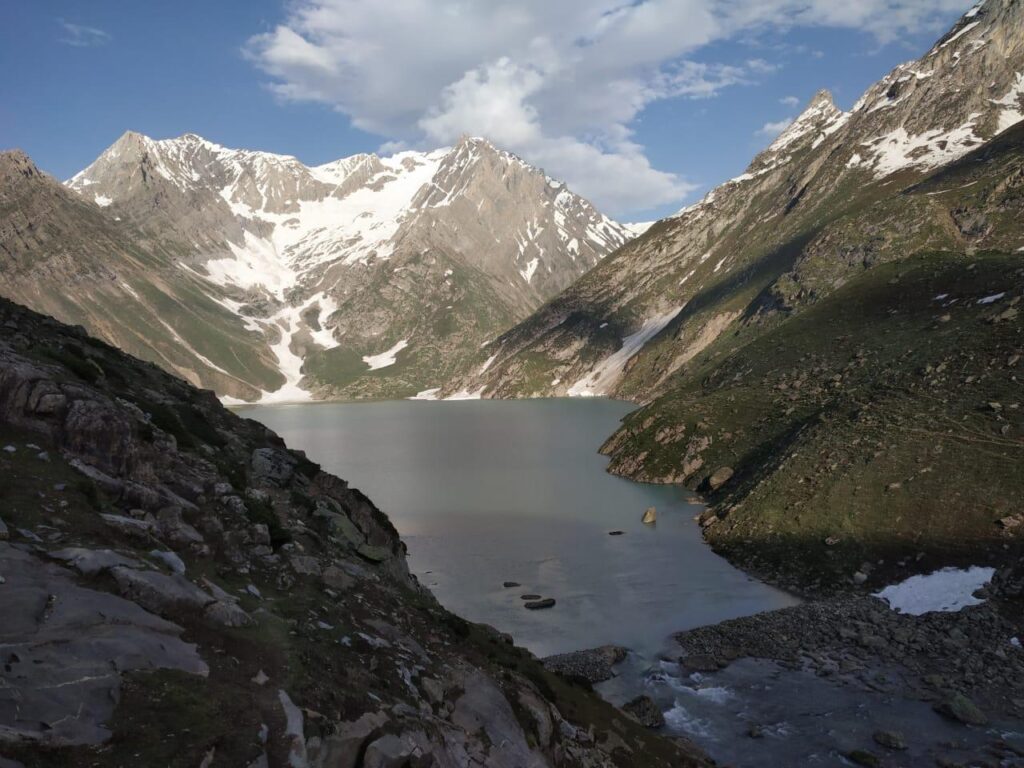
Sheshnag Lake on the Amarnath pilgrimage route surrounded by snow-capped mountains
The Pilgrimage Routes and Journey
Traditional Pahalgam Route
The traditional Pahalgam route covers approximately 36-48 kilometers and typically takes 3-5 days to complete. This longer but more gradual path begins at Nunwan base camp near Pahalgam and passes through several spiritually significant locations:
- Chandanwari (16 km from Pahalgam): The actual starting point of the trek, where pilgrims begin their foot journey
- Sheshnag Lake (11 km from Chandanwari): A pristine high-altitude lake surrounded by snow-capped peaks, named after the mythical serpent
- Panchtarni (6 km from Sheshnag): The confluence of five streams, representing the five elements
- Amarnath Cave (6 km from Panchtarni): The final destination
This route is preferred by elderly pilgrims and families as it offers multiple rest points, established camping facilities, and a more manageable gradient.
Baltal Route: The Challenging Alternative
The Baltal route presents a more demanding option, covering approximately 16 kilometers that must typically be completed in a single day due to the absence of overnight camping facilities. Starting from Baltal base camp (15 kilometers from Sonamarg), this route features steep terrain and requires excellent physical fitness. Despite its challenges, many pilgrims prefer this route for its directness and the intensity of the spiritual experience it provides.
Modern Transportation Options
Contemporary pilgrimage infrastructure includes helicopter services from both Pahalgam and Baltal to Panchtarni, reducing the trekking distance to just 6 kilometers. These services, operated under strict safety protocols, require pilgrims to possess Compulsory Health Certificates (CHC) and cost between INR 3,000 to 25,000 depending on the route and booking timing. Additional transportation options include horse rides and doli services (sedan chairs carried by porters), though animal welfare concerns have led to recommendations against horse usage.
Registration and Safety Protocols
Mandatory Registration Process
All pilgrims must register through the Shri Amarnathji Shrine Board (SASB) either online or at designated bank branches including J&K Bank and Punjab National Bank. The registration process requires valid identification documents and payment of a nominal fee. Each registered pilgrim receives an RFID card that must be collected from designated locations in Jammu or Kashmir before beginning the yatra.
Health and Safety Requirements
Given the extreme altitude and challenging conditions, strict health protocols are enforced. Children below 13 years, adults above 75 years, and women more than 6 weeks pregnant are prohibited from undertaking the pilgrimage. All participants must undergo medical examinations and carry health certificates. The high altitude poses significant risks including altitude sickness, hypothermia, and cardiac complications.
Medical facilities are strategically placed every 2 kilometers along the pilgrimage routes, staffed by qualified medical personnel and equipped to handle emergency situations. Despite these precautions, hundreds of deaths occur annually, primarily from cardiac and pulmonary causes related to the extreme conditions.
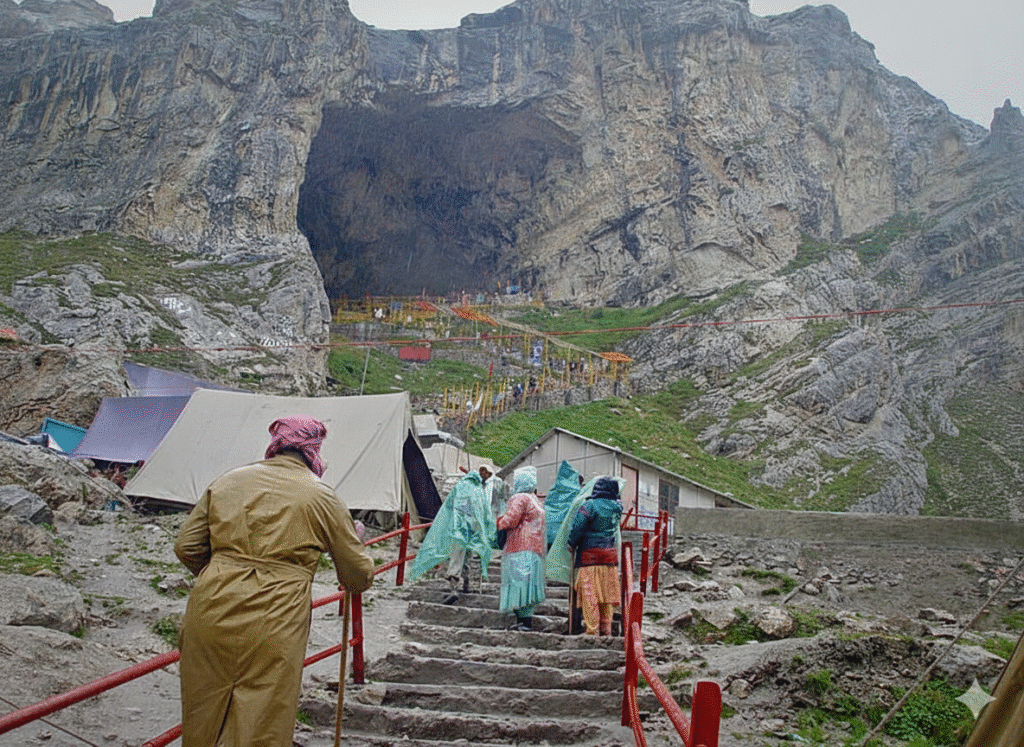
Pilgrims ascending the stairway to Amarnath Cave in the Himalayas during pilgrimage season
Environmental Impact and Climate Concerns
Ecological Challenges
The massive influx of pilgrims—over 600,000 annually in recent years—has created significant environmental challenges in this fragile Himalayan ecosystem. Water pollution in the Lidder River, the primary water source for numerous villages in south Kashmir, has become a critical concern as makeshift facilities discharge waste directly into the river system. The continuous pollution threatens both human health and aquatic life throughout the region.
Air and noise pollution from increased vehicular traffic, coupled with extensive plastic waste despite official bans, further degrades the pristine mountain environment. The conversion of traditional trekking paths into motorable roads has disrupted natural drainage patterns and contributed to soil erosion and landslides.
Climate Change Impact
Climate change has emerged as perhaps the greatest threat to the pilgrimage’s future sustainability. The premature melting of the ice lingam—now occurring weeks earlier than in previous decades—reflects broader environmental changes affecting the entire Himalayan region. Rising temperatures, unpredictable weather patterns, and changing precipitation cycles threaten not only the formation of the sacred ice lingam but also the safety of pilgrims who face increasingly erratic conditions.
Environmental experts urgently recommend conducting comprehensive environmental impact assessments, limiting pilgrim numbers, restoring natural trekking routes, and implementing stricter waste management protocols to preserve this sacred site for future generations.
Spiritual Significance and Contemporary Relevance
Shakti Peetha Designation
Beyond its association with Lord Shiva, the Amarnath Cave holds additional significance as one of the 51 Shakti Peethas, marking locations where parts of Goddess Sati’s body are believed to have fallen after her self-immolation. This dual significance—as both a Shiva shrine and a Shakti Peetha—makes Amarnath unique among Hindu pilgrimage sites, representing the divine union of masculine and feminine cosmic principles.
Modern Pilgrimage Experience
Contemporary pilgrims describe the Amarnath Yatra as transformative, combining physical challenge with profound spiritual reward. The journey demands not only physical preparation but also mental resilience and unwavering faith. Many devotees report experiencing divine darshan (sacred viewing) even when the ice lingam is not fully formed, suggesting that the cave’s spiritual power transcends its physical manifestations.
The pilgrimage’s timing during Shravan month (July-August) aligns with monsoon season, creating additional challenges but also symbolic significance as devotees believe Lord Shiva himself visits the cave on the full moon day of Raksha Bandhan. This belief drives the urgency many pilgrims feel to complete their journey during the brief window when the cave is accessible.

Scenic views of Sheshnag Lake along the Amarnath Cave pilgrimage route
Cultural Integration and Social Harmony
Hindu-Muslim Cooperation
The Amarnath pilgrimage represents a remarkable example of interfaith cooperation and cultural harmony. The local Muslim population, particularly in Pahalgam and surrounding areas, plays a crucial role in supporting the pilgrimage through hospitality services, guide assistance, and logistical support. The tradition of sharing pilgrimage donations with the descendants of Buta Malik, the Muslim shepherd credited with the cave’s rediscovery, symbolizes the inclusive nature of this sacred journey.
Economic Impact
The annual pilgrimage generates significant economic activity throughout Kashmir, providing employment opportunities for thousands of local residents including guides, porters, shopkeepers, and service providers. However, this economic benefit must be balanced against environmental costs to ensure sustainable development that preserves both the region’s natural heritage and its economic potential.
Preparing for the Sacred Journey
Physical and Mental Preparation
Prospective pilgrims should begin physical conditioning at least two months before their planned journey, focusing on cardiovascular fitness, leg strength, and altitude acclimatization. Mental preparation through meditation, prayer, and spiritual practices helps pilgrims maintain focus and resilience during challenging moments of the trek.
Essential Equipment and Supplies
Proper equipment is crucial for safety and comfort. Essential items include waterproof trekking shoes, layered warm clothing, rain gear, headlamps, first aid supplies, and oxygen pouches for altitude sickness prevention. All belongings should be stored in waterproof bags to protect against sudden weather changes common in the mountains.
Conclusion: A Timeless Spiritual Legacy
The Amarnath Cave stands as a testament to the enduring power of faith and the profound connection between the divine and the natural world. This sacred site, where ice and stone combine to create a symbol of eternal divinity, continues to draw pilgrims from across the globe despite increasing environmental challenges and logistical complexities. The pilgrimage represents more than a religious journey—it embodies humanity’s eternal quest for transcendence, self-discovery, and union with the divine.
As climate change and human pressure threaten this ancient shrine, the need for sustainable pilgrimage practices becomes increasingly urgent. The future of Amarnath Cave depends on balancing devotional access with environmental protection, ensuring that this miraculous natural temple continues to inspire and transform pilgrims for generations to come. The cave’s message remains timeless: through dedication, sacrifice, and unwavering faith, seekers can discover the secrets of immortality not in the permanence of ice and stone, but in the eternal nature of the human spirit’s connection to the divine.
Whether pilgrims witness the fully formed ice lingam or simply experience the cave’s sacred atmosphere, the Amarnath journey offers profound spiritual rewards that transcend physical manifestations. In this high-altitude sanctuary where earth meets sky and the temporal encounters the eternal, devotees continue to find the divine presence that has made this remote Himalayan cave one of the world’s most significant pilgrimage destinations.


